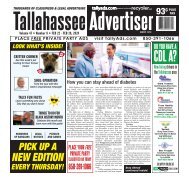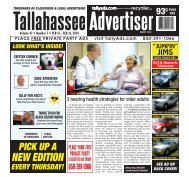TLA23_AllPages_R
You also want an ePaper? Increase the reach of your titles
YUMPU automatically turns print PDFs into web optimized ePapers that Google loves.
SPEED LIMITERS<br />
Will the proposed rule requiring speed limiters get swallowed up in President<br />
Donald Trump’s pledge to reduce the number of federal regulations imposed on the<br />
American public?<br />
And just how necessary is such a rule in the first place, especially one that doesn’t deal<br />
with the differential between the speed of trucks and the speed of passenger vehicles?<br />
“A clear majority of members have speed limiters on their vehicles,” said David Heller,<br />
vice president of government affairs at the Truckload Carriers Association. “They are all<br />
limited at different speeds, all the way from 58, where they are operating in urban settings,<br />
to as high as 68 miles per hour. The inherent argument is what is the right speed and if<br />
all the trucks are going that speed, will that create a logjam and at what point do we start<br />
talking about differentials?”<br />
Those differentials already exist, Heller said.<br />
“As long as this industry has been around we’ve been dealing with cars operating in<br />
and around trucks and doing so in an unsafe fashion,” he said. “And when you have cars<br />
operating in a manner where they can go faster than trucks, or vice versa, the differential<br />
is going to exist. We don’t have a limiting standard right now in this country and the differential<br />
is there. If we did have a limiting standard in this country the differential would<br />
still be there.”<br />
For the record, TCA’s policy on the issue of speed limiters is that all vehicles should<br />
be limited at 65 mph.<br />
Meanwhile, safety advocates are concerned about the future of speed limiters in light<br />
of the new administration’s regulation freeze.<br />
“I am really disappointed if the rule is not done right away,” said Truck Safety Coalition<br />
Executive Director John Lannen, who hoped for quick action because the measure<br />
has been in the works for more than a decade. “I’m hoping that safety regulations do get<br />
looked at differently than maybe just generic regulations because we’re trying to save<br />
lives.”<br />
Steve Owings, co-founder of Road Safe America and who originally proposed the rule,<br />
said advocates will reach out to the new administration to keep the regulation going.<br />
“This, as well as other needed changes, certainly fits the description of ‘common<br />
sense,’ which the president-elect has spoken of recently,” said Owings, whose son was<br />
killed by a speeding truck while returning to college in 2002.<br />
The Owner-Operator Independent Drivers Association “vehemently” opposes the rule,<br />
the organization said in comments filed with the National Highway Traffic Safety Administration<br />
and Federal Motor Carrier Safety Administration, calling it “damaging to owner-operators’<br />
and independents’ ability to compete in the marketplace against larger carriers.”<br />
Independent truckers, many of whom filed comments against the rule, say the government<br />
is actually creating conditions for more collisions by focusing on the severity of the<br />
crash while ignoring the dynamic of trucks and cars traveling at different speeds. They<br />
warn of traffic jams caused by slower trucks and of a potential increase in crashes caused<br />
by fast-moving cars hitting the rear of trucks.<br />
Owings says the rule should apply to existing trucks instead of just new ones because<br />
speeds could be limited with an inexpensive software update.<br />
The speed limiters also would take care of the problem of trucks traveling at faster<br />
speeds than their tires can handle.<br />
An investigation by The Associated Press last year found that most truck tires can’t<br />
handle speeds above 75 mph, yet some states let trucks go 80 mph or even 85 mph.<br />
SLEEP APNEA<br />
There appears to be no middle ground when it comes to the prospect of a<br />
rulemaking on sleep apnea based on a review of the comments received in response<br />
to the Advanced Notice of Proposed Rulemaking on the Evaluation of Safety Sensitive<br />
Personnel for Moderate-to-Severe Obstructive Sleep Apnea issued jointly last<br />
year by the Federal Motor Carrier Safety Administration and the Federal Railroad<br />
Administration.<br />
The following comments summarize the polarization between those for such a rule and<br />
those against, especially in light of the recommendation of the FMCSA Medical Review<br />
Board (MRB) that would require mandatory screening for any truck driver with a body<br />
mass index (BMI) of 40 or more who has admitted fatigue or sleeping during wakeful periods,<br />
or for any drivers who have been involved in sleep-related motor vehicle accidents,<br />
and for anyone who possesses a BMI of 33 and has at least three of a number of risk<br />
factors, two of which are being male and age 42 or older.<br />
A primary care physician who is a certified medical examiner had this to say:<br />
“I agree that sleep apnea is a major concern for commercial drivers. I have seen many<br />
drivers apply for their CDLs who suffer from morbid obesity, an unfortunately common<br />
consequence of the driver lifestyle. Some even show up to the test appointment looking fatigued.<br />
While many work longer hours than anyone should, and some have an easily-fixed<br />
unhealthy lifestyle that contributes as well, the rate of sleep apnea among this morbidly<br />
obese subset is astounding. As there are [now] no definitive guidelines about sleep apnea,<br />
drivers often become angry when I request they undergo testing. The rate of moderate<br />
or severe apnea among these drivers in my experience has been quite high though, so I<br />
continue to push them for evaluation. As an examiner and physician, I am not only trying to<br />
reduce traffic accidents among these drivers, I am trying to save their lives.”<br />
One professional driver said:<br />
“I find the logic of using either BMI or neck size as an indication of obesity outrageous<br />
and unscientific. For example, BMI makes no allowance for the relative proportions of<br />
bone, muscle and fat in the body. But bone is denser than muscle and twice as dense as<br />
fat, so a person with strong bones, good muscle tone and low fat will have a high BMI.<br />
Thus, athletes and fit, health-conscious movie stars who work out a lot tend to find themselves<br />
classified as overweight or even obese. Moreover, neck size is a poor indicator<br />
of the possibility of obstructive breathing during sleep. What sort of ‘junk science’ is the<br />
FMCSA promoting these days? A terrible waste of money and time are spent on this illogical<br />
reasoning. This is the most cockeyed piece of regulatory thinking ever.”<br />
Another driver stated that:<br />
“The presumption for requiring a test is ridiculous. When I was a junior in high school, I<br />
weighed 120 pounds and had a 17-inch neck. I couldn’t buy clothes then and can’t now. I<br />
have done a sleep test three times, passing each time. The fact that anyone with a badge<br />
can condemn me to a $4,000 test and lost wages is outrageous. I will not submit to another<br />
test without sound scientific reasoning that would indicate a test is necessary. And I am not<br />
paying for it. It takes 10 percent of my yearly income for a test and I could be remanded to<br />
take another the next day I am on the road. I will go flip burgers. They make more money<br />
for less time out of their lives anyway.”<br />
The problem is that the MRB’s recommendations — which are non-binding — are<br />
vast, said David Heller, vice president of regulatory affairs at the Truckload Carriers Association.<br />
“Their recommendations would affect the majority of the trucking industry,” Heller said.<br />
“We can’t have a rule that doesn’t pass muster with the Office of Management and Budget<br />
because of its vastness.”<br />
“TCA takes the position that it supports the overall health and well-being of drivers<br />
and that those health improvements will hopefully decrease the diagnoses of sleep apnea<br />
or other fatigue-inducing conditions, restless leg syndrome being one. If you narrow the<br />
scope to sleep apnea, we are limiting our playing field, so to speak, when we could take<br />
steps to improve overall driver health and thus reduce sleep apnea among drivers and<br />
probably reduce other health issues as well, including diabetes, congestive heart failure<br />
and high blood pressure, to name a few.<br />
“Maybe if we as an industry circumvented any regulations proposed by MRB and started<br />
talking preventive medicine, we could turn out far better in the long run than we could<br />
with a rule on sleep apnea.”<br />
In support of its members who oppose mandatory screening, the Owner-Operator<br />
Independent Drivers Association through the OOIDA Foundation recently published a<br />
white paper pointing out that sleep apnea is a medical condition that has been common<br />
for many years and that the FMCSA’s own statistics don’t support the “sudden” need for<br />
increased scrutiny in the form of a new federal regulation.<br />
The foundation said data from the FMCSA’s “Large Truck and Bus Crash Facts” in<br />
2013 and 2014 supported its claim.<br />
The data showed that in 2011 only 1.8 percent of fatal crashes were attributed to<br />
impairment-related factors. In 2012, the figure was 1.7 percent, in 2013 it was 1.4 percent<br />
and in 2014 it was 1.8 percent.<br />
“Irrespective of the facts, FMCSA as well as others continue to disseminate misperceptions<br />
and falsehoods concerning sleep apnea and its safety impacts on the trucking<br />
industry,” the foundation said.<br />
OOIDA also cited a 2004 crash risk study that said patients with sleep apnea had no<br />
greater probability of having a crash than patients without sleep apnea, either before or<br />
after their diagnoses.<br />
The white paper also questioned the effectiveness of using CPAP machines to treat all<br />
sleep apnea patients, noting that some users of CPAP machines had reported a decrease<br />
in restful sleep.<br />
The Department of Transportation’s report on significant rulemakings does not reflect<br />
a date when the agencies might move to the Notice of Proposed Rulemaking<br />
stage, or even if they will, especially in light of the Trump administration’s freeze on<br />
new regulations.<br />
TCA 2017 www.Truckload.org | Truckload Authority 13

















